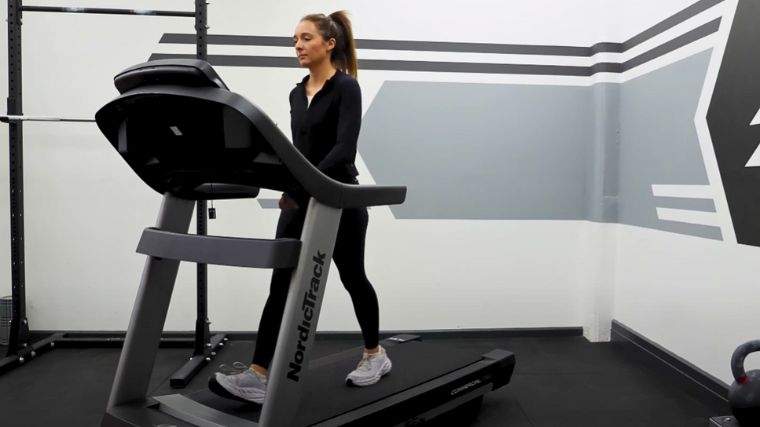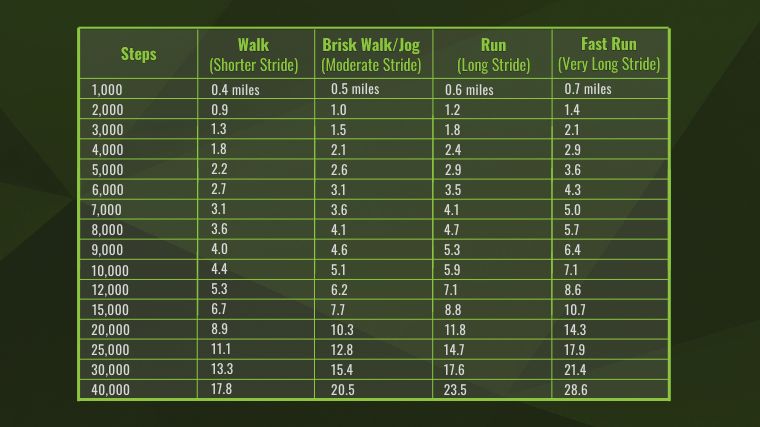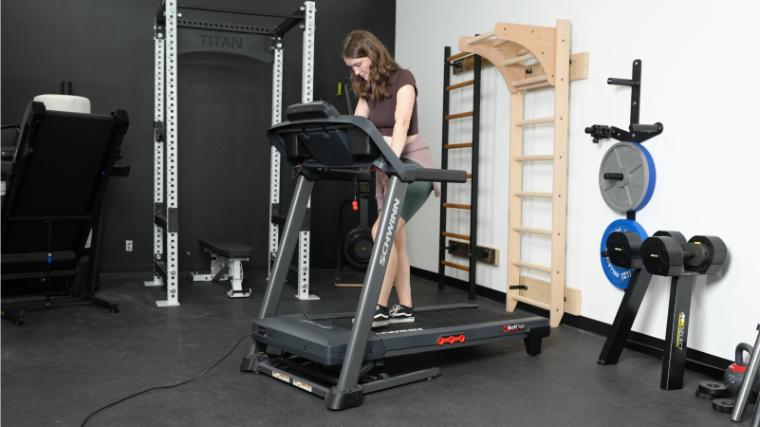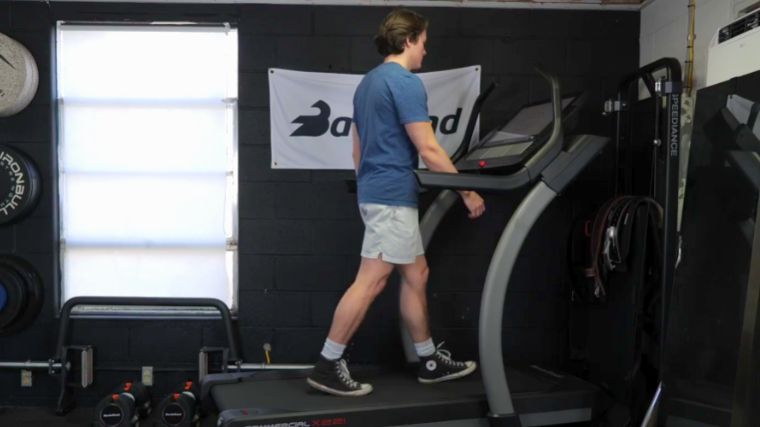Since the advent of the pedometer, people have been counting their steps to maintain a healthy body weight and improve cardiovascular fitness. But thanks to the rise of smartphones and smartwatches, which, in conjunction with fitness trackers, can monitor how many steps are in a mile along with your personal gait speed, what was once a niche fitness trend has become ubiquitous across a wide range of professions and lifestyles.

If you’re not already counting your steps, it’s time to jump on board. Measuring your steps is a proven and convenient way to increase your overall fitness. (1) “Maintaining a solid daily step count is one of the most consistent and accessible ways to lose weight and improve your health,” says BarBend Senior Writer and B.S.-EXS Jake Dickson. So, if you want to measure your mileage, you need to know how many steps you’re covering while you walk.
From BarBend Expert Gianna Masi: “What really matters for your health and body composition is to take inventory of how many steps you currently take in a day, or in a week on average. From there, you can assess if you’re currently at 3,000 steps per day, progress to 4,000 etc. The key is to treat it like any other progression in the gym. You can work up to a higher target over time.”
How Many Steps Are in a Mile?
Not all steps are made equal, and there isn’t an exact answer. There are roughly 2,100 steps in a mile when walking and 1,600 steps in a mile when running. However, that answer comes with a bit of nuance attached.

The number of steps a person takes to reach a mile depends almost entirely on their stride length. You can measure the length of your stride by finding the distance between the heel of your front foot and the toe of your back foot. Your stride length is primarily determined by two factors: Your height and your speed. (2)
[Read More: How To Balance Running And Strength Training]
Studies show that when people walk, the length of the average step is 31 inches, or roughly 2.5 feet. (3) Since there are 5,280 feet in a mile, you can estimate that, if you average 2.5 feet per step, you’ll take roughly 2,100 steps to reach a mile. That number changes when you pick up the pace.

When you run, your stride length increases on average by 28% over your walking stride length. (4) So if you average 2.5 feet per step while walking, you’ll average 3.3 feet per step while running, for an estimated 1,600 steps per mile while running.
How Many Steps Do You Need Per Day?
You’ve probably heard of the 10,000-steps-a-day regimen, which is often held up as the gold standard for regular walking habits. While that exact figure is a convenient, easy-to-remember, and marketable number, there’s nothing inherently magical about walking (about) five miles per day.
That 10,000-steps-per-day number dates back to 1965, according to Harvard Health Publishing. A Japanese company produced a pedometer called Manpo-kei, which translates to “10,000 steps meter.” The marketing stuck and 10,000 steps per day is considered a benchmark worth reaching.
[Read More: The Best Fitness Trackers For Heart Rate, Sleep, Steps, And More]
You don’t necessarily need to walk 10,000 steps to be healthy. However, most modern literature on walking habits does indicate that, for the most part, more is better. (5)
“You can certainly have too much of a good thing when it comes to exercise, but most people don’t need to worry about that if their main form of cardio is walking,” Dickson says.
Tips for Increasing Your Step Count
You might think reaching 10,000 steps a day sounds disheartening, or even downright impossible. Fortunately, you don’t need to make any drastic changes to your lifestyle to start seeing the benefits of increasing your steps — even adding a thousand more steps in your daily routine can yield positive results for your overall health. (5) Here are a few tips to increase your step count:
- Use a fitness tracking app: Studies have shown that you can increase your daily steps by as much as 2,500 per day just by measuring them with either a pedometer or with a fitness app.(1) Fitness apps can also help you measure progress, and integrate your steps with your other activity, giving you more flexibility when it comes to reaching your daily fitness goals.
- Take phone calls on the go: If you routinely take work (or personal) calls sitting down, try walking around while gabbing. It doesn’t matter whether you stroll outside, pace your office, or walk in place — just getting moving. On average, it takes about 20 minutes to walk one mile, meaning you can accumulate about 2,000 steps (or more) during a call.
- Make your steps social: Walking shouldn’t feel like a chore. Group activities like hiking, group fitness classes, or recreational sports can be a great way to increase your overall steps while having fun and getting involved in your community.
[Read: Why We Recommend Walking for Weight Loss]
More Helpful Tips
Here are some other useful tips for ratcheting up your step count or getting more cardio in general:
Pick Up The Pace
Increasing your walking pace can increase your ATP max and your Vo2 max, which in turns means you can push yourself harder for longer in the gym. (7) Additionally, by picking up the pace you could actually improve your rate of recovery. Studies have shown that maximum blood lactate clearance occurs closer to your lactate threshold, meaning that you can reduce the soreness you experience after a workout just by walking at a brisker pace. (14)
Do It Right After You Lift
Timing your walk can make all the difference from a recovery perspective. Active recovery is most effective at preventing delayed onset muscle soreness (DOMS) when implemented shortly after exercise. (13)

“10 to 20 minutes on the treadmill after a strength training session is a superb way to cool down from your workout,” Dickson recommends. “You can also do a bit of backwards walking on the treadmill after leg day to safeguard your hips and knees.”
Watch Where You’re Walking
Where you choose to walk will change the benefits you get from walking. If you’re primarily interested in reducing your overall stress, exploring the outdoors will do a lot more for you than treadmill walking.
[Read More: The Best Treadmills for Walking]
Studies show that going for a walk in nature lowers cortisol significantly more than when you walk on a treadmill. (16) Alternatively, if you’re concerned with the impact force that walking may produce, a treadmill offers the lowest-impact option available. (17)
Difference Between Running a Mile and Walking a Mile
While walking and running might not feel so similar while you’re doing them, studies show that in a lot of ways, your body can’t tell the difference. Walking and running reduce your risk of hypertension, high cholesterol, and diabetes at similar rates, and even give you similar improvements to your Vo2 max (the amount of oxygen your body can use during exercise). (6)(7) Both activities are forms of low-intensity steady-state (LISS) cardio that can help you maintain an active lifestyle.
[Read More: The Best Treadmills For Running For Incline, Durability, Tech, And More]
Whether you choose to walk or run a mile depends on your goals. If you want to lose weight, running might initially seem like the best option. After all, when you engage in aerobic exercise your energy expenditure increases as you pick up the pace. (8) Step-for-step, you burn more calories running than you do walking. While running is objectively a more efficient calorie-burner than walking, the best form of aerobic activity for weight loss or maintenance is the one you stick with long term.
[Read More: The Best Online Workout Programs For Coaching, Cardio, Value, And More]
The other main benefit of cardio is conditioning. Athletes frequently incorporate body conditioning into their training to strategically improve their Adenosine triphosphate reserves (ATP). You can think of ATP as fuel for your muscles at the cellular level. While walking does improve your overall energy capacity, it doesn’t measure up to the boost you get from running. (9)
Benefits of Walking For Strength Athletes
There was a time when cardio was taboo for strength athletes. That time has passed. Here are some of the reasons that you should incorporate walks into your daily routine.
Reduced Cortisol
Have you noticed that your performance in the gym suffers when you’re stressed out? It turns out it’s not just in your head. Cortisol is your body’s response to both physical and mental stressors, providing you with energy right away via catabolic processes, which make it harder for you to recover from intense exercise. (10)

[Read More: 3 Reasons Why You Should Perform Cardio After Lifting]
Studies show that walking not only lowers levels of salivary cortisol, but it also lowers the amount of cortisol your body releases during stressful situations. (11) Going for regular walks has also been shown to improve overall mental health, which may have the side benefit of further reducing cortisol. (13)
Push Yourself Harder In the Gym
Think of your cardiovascular system like a car engine. Going for regular walks improves your Vo2 max (the amount of oxygen you can utilize during intense activity), effectively letting you go pedal-to-the-floor for longer without redlining. (7) In practical terms, that means you can hit the gym harder and longer before you reach the point of exhaustion.
Helpful For Weight Loss And Maintenance
After a long winter of bulking, eating whatever you want, cutting can be a truly grueling experience. The calories burned by incorporating regular walks into your routine can make a huge difference for both cutting and maintenance, giving you a nice little bonus to your caloric budget that satiates your hunger while staying in a caloric deficit. Even if you’re not interested in counting calories, studies show that walking can help you maintain a consistent bodyweight over the long-term. (12)
Improves Muscle Recovery Time
Incorporating LISS cardio after an intense gym session could be considered active recovery. Forms of active recovery, like walking, have been shown to prevent delayed onset muscle soreness (DOMS) and improve blood lactate clearance, allowing you to hit the gym again more quickly after your workout. (14)(15)
Frequently Asked Questions
How many miles is 10,000 steps?
Most folks clear about two and a half feet per step, which works out to 10,000 steps covering just about five miles.
How many steps are in 2 miles?
Most people will log around or just under 5,000 steps if they walk two miles.
References
- Bassett DR Jr, Toth LP, LaMunion SR, Crouter SE. Step Counting: A Review of Measurement Considerations and Health-Related Applications. Sports Med. 2017 Jul;47(7):1303-1315. doi: 10.1007/s40279-016-0663-1. PMID: 28005190; PMCID: PMC5488109.
- Ugochukwu, Esomonu Godfrey; Augustine, Egwu Ogugua1; Samuel, Eno2; Ifechukwude, Biose. Estimation of Stature from Stride Length and Lower Limb Length of Efiks in Calabar South, Cross River State, South-South Nigeria. Journal of the Anatomical Society of India 70(4):p 216-220, Oct–Dec 2021. | DOI: 10.4103/JASI.JASI_63_20
- Murray, M.P., Drought, A.B., & Kory, R.C. (1964). WALKING PATTERNS OF NORMAL MEN. The Journal of bone and joint surgery. American volume, 46, 335-60 .
- Cavanagh PR, Kram R. Stride length in distance running: velocity, body dimensions, and added mass effects. Med Sci Sports Exerc. 1989 Aug;21(4):467-79. PMID: 2674599.
- Jayedi A, Gohari A, Shab-Bidar S. Daily Step Count and All-Cause Mortality: A Dose-Response Meta-analysis of Prospective Cohort Studies. Sports Med. 2022 Jan;52(1):89-99. doi: 10.1007/s40279-021-01536-4. Epub 2021 Aug 21. PMID: 34417979.
- Williams PT, Thompson PD. Walking versus running for hypertension, cholesterol, and diabetes mellitus risk reduction. Arterioscler Thromb Vasc Biol. 2013 May;33(5):1085-91. doi: 10.1161/ATVBAHA.112.300878. Epub 2013 Apr 4. PMID: 23559628; PMCID: PMC4067492.
- Suter E, Marti B, Gutzwiller F. Jogging or walking–comparison of health effects. Ann Epidemiol. 1994 Sep;4(5):375-81. doi: 10.1016/1047-2797(94)90072-8. PMID: 7981845.
- Wilkin LD, Cheryl A, Haddock BL. Energy expenditure comparison between walking and running in average fitness individuals. J Strength Cond Res. 2012 Apr;26(4):1039-44. doi: 10.1519/JSC.0b013e31822e592c. PMID: 22446673.
- Baker JS, McCormick MC, Robergs RA. Interaction among Skeletal Muscle Metabolic Energy Systems during Intense Exercise. J Nutr Metab. 2010;2010:905612. doi: 10.1155/2010/905612. Epub 2010 Dec 6. PMID: 21188163; PMCID: PMC3005844.
- Thau L, Gandhi J, Sharma S. Physiology, Cortisol. [Updated 2022 Aug 29]. In: StatPearls [Internet]. Treasure Island (FL): StatPearls Publishing; 2023 Jan-. Available from: https://www.ncbi.nlm.nih.gov/books/NBK538239/
- Wood CJ, Clow A, Hucklebridge F, Law R, Smyth N. Physical fitness and prior physical activity are both associated with less cortisol secretion during psychosocial stress. Anxiety Stress Coping. 2018 Mar;31(2):135-145. doi: 10.1080/10615806.2017.1390083. Epub 2017 Oct 16. PMID: 29037088.
- Miriam E Nelson, Sara C Folta, Further evidence for the benefits of walking, The American Journal of Clinical Nutrition, Volume 89, Issue 1, January 2009, Pages 15–16, https://doi.org/10.3945/ajcn.2008.27118
- Zhu Z, Chen H, Ma J, He Y, Chen J, Sun J. Exploring the Relationship between Walking and Emotional Health in China. Int J Environ Res Public Health. 2020 Nov 27;17(23):8804. doi: 10.3390/ijerph17238804. PMID: 33260796; PMCID: PMC7734587.
- Dupuy O, Douzi W, Theurot D, Bosquet L, Dugué B. An Evidence-Based Approach for Choosing Post-exercise Recovery Techniques to Reduce Markers of Muscle Damage, Soreness, Fatigue, and Inflammation: A Systematic Review With Meta-Analysis. Front Physiol. 2018 Apr 26;9:403. doi: 10.3389/fphys.2018.00403. PMID: 29755363; PMCID: PMC5932411.
- Menzies P, Menzies C, McIntyre L, Paterson P, Wilson J, Kemi OJ. Blood lactate clearance during active recovery after an intense running bout depends on the intensity of the active recovery. J Sports Sci. 2010 Jul;28(9):975-82. doi: 10.1080/02640414.2010.481721. PMID: 20544484.
- Kobayashi H, Song C, Ikei H, Park BJ, Kagawa T, Miyazaki Y. Combined Effect of Walking and Forest Environment on Salivary Cortisol Concentration. Front Public Health. 2019 Dec 12;7:376. doi: 10.3389/fpubh.2019.00376. PMID: 31921741; PMCID: PMC6920124.
- Yao J, Guo N, Xiao Y, Li Z, Li Y, Pu F, Fan Y. Lower limb joint motion and muscle force in treadmill and over-ground exercise. Biomed Eng Online. 2019 Aug 22;18(1):89. doi: 10.1186/s12938-019-0708-4. PMID: 31438944; PMCID: PMC6704526.